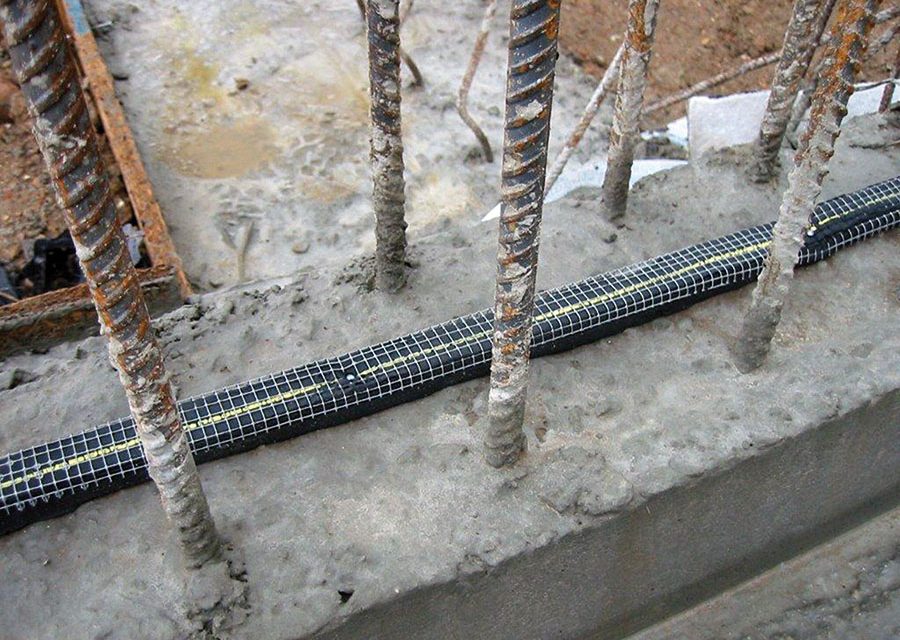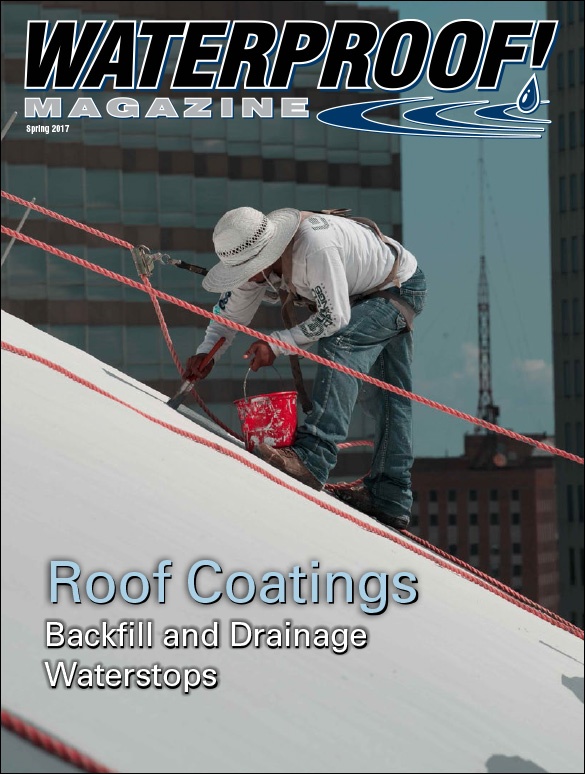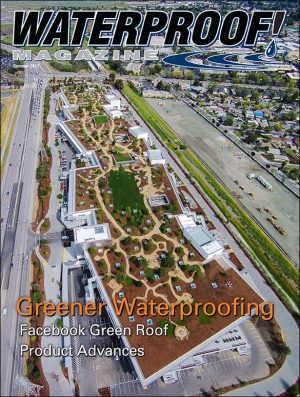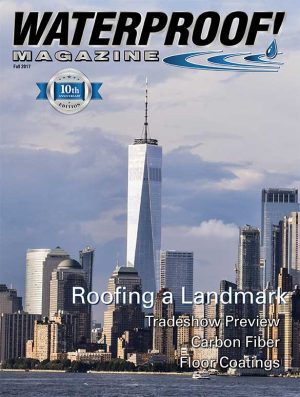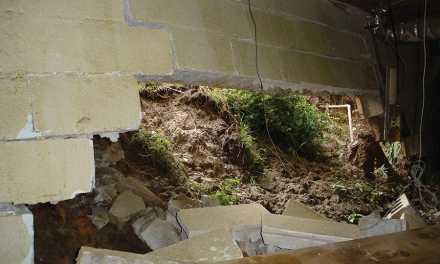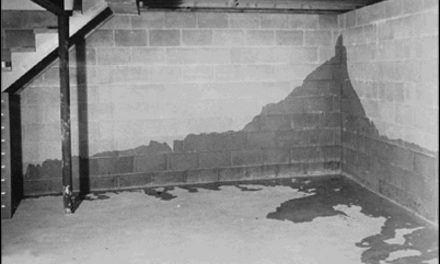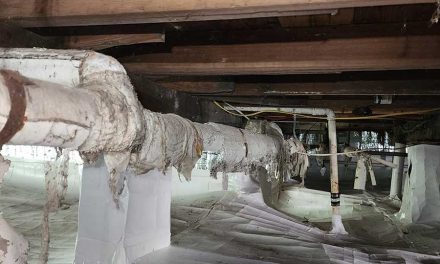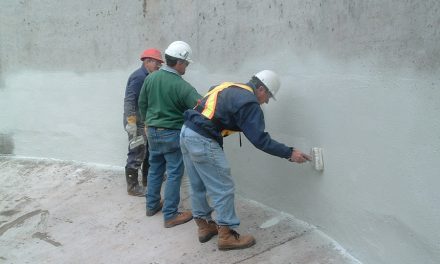Waterstop is a material that is embedded in the concrete, across the concrete joint, to obstruct the passage of water through the joint.
A waterstop installed in concrete joints is an important component of the overall waterproofing design. Use of a waterstop with a waterproofing membrane is considered a belt-and-suspenders approach to provide a dry basement. This is a common practice in waterproofing design because if for some reason water is able to circumvent the membrane, the waterstop is in position to obstruct the water in the most likely place the water leak can occur – through the concrete cold joint. Beyond the concrete cold joint, waterstops are unable to prevent water ingress through cracks that develop in the concrete due to building settlement, load deflection, or concrete shrinkage —waterproofing membrane systems, are available for these crack issues.
What is a Waterstop
Many construction professionals generally think of waterstop as being a dumbbell profile extrusion of PVC thermoplastic, four to nine inches wide, installed in a concrete joint. These dumbbell products have been the most widely used waterstop for decades. Today, there is a wide variety of materials—metal, bentonite, asphaltic, and hydrophilic rubber—with differing compositions, sizes and profiles, used as waterstops in concrete structures. Waterstop is not an elastomeric sealant or coating adhered to the concrete surface at a joint.

It is important the waterstop be manufactured with quality raw materials, without defects. Many material types and profiles are available for different applications and joint conditions. To choose a waterstop suitable for the project’s joint-sealing needs, it is important to know the various product types and material compositions. Most types are manufactured exclusively for use in cast-in-place concrete construction joints (i.e. cold joints), while some can also be used with expansion joints (See story on p. 19). Selected waterstops must accommodate the expected lateral, transverse, and shear joint movements, as well as, the expected hydrostatic pressure.
Standard Types of Waterstops
Waterstops are manufactured in various types, shapes (profiles), sizes, and material compositions. Standard types of waterstops include PVC thermoplastic extrusions, hydrophilic bentonite and rubber strips, and injection hose systems.
PVC Thermoplastic Extrusions
To accommodate varying hydro-static pressure and movement, most PVC waterstops come in different extruded profiles, widths, and thicknesses. For several decades, the most widely used waterstops were those having a dumbbell shape. Today, waterstop manufacturers have developed profiles with multiple raised ribs to provide improved anchoring and sealing performance.
Both ribbed and dumbbell waterstops are available with flat-web or bulbed centers. They typically are available in 50-ft. rolls, in widths of 4 in. to 12 in., and material thicknesses of 3/16 in. to ½ in. Flat-web waterstops are recommended for use in construction and contraction joints where little or no movement is expected. Since the center bulb flexes to accommodate both shear and transverse movements, these waterstops can be used in expansion, contraction, or construction joints. The center bulbs come in various sizes to accommodate differing amounts of joint movement, with larger-diameter center bulbs suitable for greater joint movements.
Some ribbed waterstops have a center bulb with a thin tear-web on one side that ruptures upon joint expansion. The tear-web keeps concrete out of the center bulb during concrete placement. With the tear-web broken, the center bulb can open up to an extended width to reduce stresses on the embedded ribbed sections. Manufacturers recommend using tear-web waterstops where large movement is expected. They should be installed so the tear-web side faces outward toward the direction of positive water pressure.
The width of the waterstop profile should be selected based on the expected head of water pressure the joint will encounter. The general rule of thumb is the larger the size of a waterstop (e.g. width), the greater the hydrostatic pressure resisted by the waterstop.
However, it is not just size that affects performance; profile material thickness and ribbing also play important roles with resisting higher hydrostatic pressures. Waterstop manufacturers can recommend size and type when actual project design conditions are available for review.
Special Thermoplastic Materials and Profiles
For better resistance to chemical fluids, dumbbell and ribbed center-bulb waterstops are produced with polyethylene and thermoplastic vulcanizate (TPV). This latter material is intended for primary and secondary containment structures, as well as ozone contactor wastewater structures. TPV waterstops are resistant to a wide range of oils, solvents, and industrial chemicals. Unlike PVC, TPV contains no plasticizer to leech out when exposed to chemicals and fuels.
Hydrophilic Waterstops
Unlike PVC dumbbell waterstops that function by passively blocking water, hydrophilic strip waterstops react with water and swell to form a positive watertight seal in the concrete joint. Commercially available for several decades, hydrophilic waterstops have a long proven track record. A hydrophilic waterstop is effective in providing protection against water infiltration through concrete construction joints, including joints under high hydrostatic pressure and intermittent hydrostatic conditions.
Hydrophilic waterstops are produced in rolls or strips. The profile is usually a small rectangle, with bentonite and rubber being the most common materials. They are used mainly in non-moving construction joints; most are not intended for use in expansion joints. These systems are simple to install, and do not have to be secured in place before the first concrete pour. Also, adjacent roll ends do not need to be heat-welded together like a PVC dumbbell waterstop. The material is adhered directly to the cured concrete using an adhesive or primer.
Hydrophilic waterstops are not limited to cast-in-place concrete construction cold joints. Due to their flexibility and conformability, hydrophilic strip waterstops can be easily installed around pipe penetrations, I-beams, concrete pilings, and irregular-shaped surfaces. Additionally, they are lightweight and flexible, and do not require any special-order prefabricated Ts, Ls, or crosses.
Since hydrophilic waterstops expand in the presence of water, the second concrete placement should take place promptly after the waterstop is installed. Otherwise, the waterstop might expand if exposed to rain.
Bentonite clay is the hydrophilic agent material in many swelling strip waterstops. However, some use different types of hydrophilic agents and may have different expansive properties (in terms of rate and volume) when exposed to water. Also, some are produced with portions of the profile made of non-swelling rubber—this means the entire profile does not activate and swell.
The maximum expansion a hydrophilic material exhibits in non-confined, free-swell conditions will not materialize in properly consolidated concrete. The plasticity and expansion properties provide it the ability to extrude the bentonite compound into cracks and advance around angle transitions that may be present in the joint.
Injection-Hose Waterstops
Injection-hose waterstops are usually a permeable or perforated hose installed during new construction with a series of injection ports and valves. These ports are placed exposed at the interior surface of the concrete for later access. Should a leak occur after construction, a grout pump can be used to inject a resin (usually polyurethane) to seal the joint and fill any adjacent voids in the concrete.
Each injection hose system uses permeable or perforated hose that is installed at construction joints, in short lengths (typically less than 30 ft.). The hose core is surrounded by a woven mesh outer layer so resin injected under pressure can pass out of the hose into the joint, but the freshly poured concrete of the second concrete pour cannot enter the hose and clog it. The hose is secured to the first concrete pour after it sets, with clamps mechanically fastened (typically 12 in. on center).
Adjacent hoses are overlapped by six to 12 in. at each segment end, with an injection port on one end exiting the concrete. After the structure is built, polyurethane resin is injected into the hose to seal the joint and fill any cracks or voids intersecting the joint. They can also be used to seal construction joints between new and existing structures.
Conclusion
Contractors have the most important role with regards to waterstops: the installation. Waterstops should be treated as strategic building envelope barrier material for the long-term success of a project. For any waterstop to be effective, proper design, installation, and concreting practices must be followed. Most importantly, one must select a product size and profile suitable for the expected joint movement, hydrostatic head, and chemical resistance required.
Stacy Byrd is the technical services director at Cetco. He has been involved with hundreds of projects throughout North America as well as Europe, Asia, South America, Australia, and the Middle East. He can be reached at stacy.byrd@cetco.com.
Spring 2017 Back Issue
$4.95
Sealing Cold Joints with Waterstops
Waterstops for Expansion Joints
Basement Backfill and Drainage
The Key to a Successful Roof Coating
AVAILABLE AS DIGITAL DOWNLOAD ONLY
Description
Description
Sealing Cold Joints with Waterstops
By Stacy Byrd
Available in a variety of profiles and materials, waterstops play a major role in preventing water leakage at cold joints.
Waterstops for Expansion Joints
By Dan Chapman
Properly installed waterstops can prevent water from penetrating expansion joints, despite significant movement in the concrete.
Basement Backfill and Drainage
Rigid foam boards and dimple drain sheets are just two of the options available to relieve hydrostatic pressure and prevent damage to the waterproofing membrane during backfill.
The Key to a Successful Roof Coating
By James R. Kirby
New technology makes it possible to extend roof life and reduce energy use without removing the existing membrane, creating dramatic savings.
Additional Info
Additional information
| Magazine Format | Digital Download Magazine, Print Mailed Magazine |
|---|

